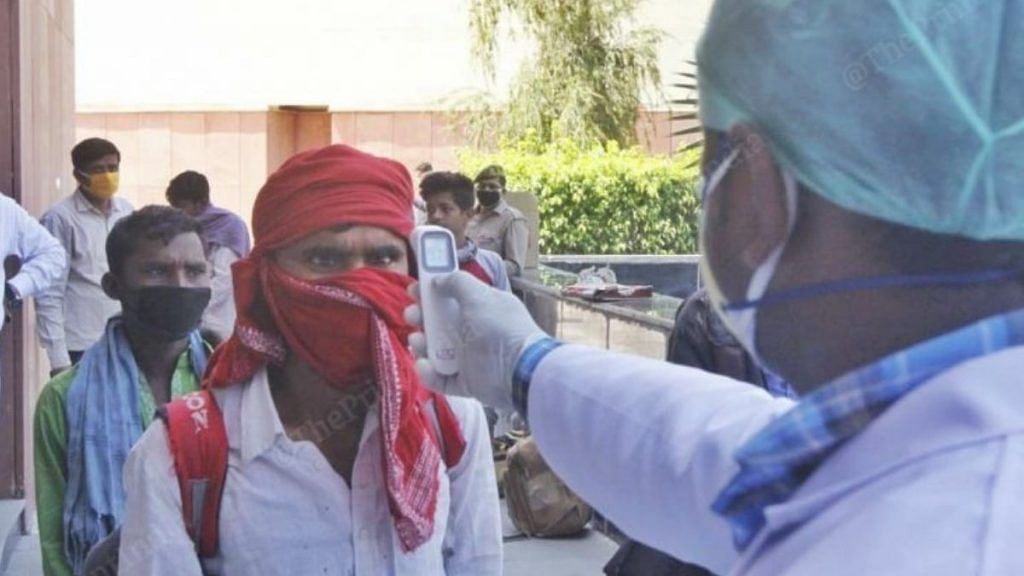New Delhi: With daily vaccinations continuing to flag and the effective reproduction rate (R) value crossing 1 for the first time since February, several modelling projections, including by experts within the government, now suggest India could be headed for a third Covid-19 peak somewhere around October-November.
A modelling projection by the University of Michigan shows that India is headed for a “small bump” towards the end of August, but the next peak is likely to hit around November.
Bhramar Mukherjee, the John D. Kalbfleisch Collegiate Professor of Biostatistics at the Michigan University, told ThePrint: “I am skeptical about the long range predictions of these forecasting models as things change rapidly depending on our actions and policy measures. Our models indicated that India would hit a trough in July.”
She added: “Our models currently predict that the infections are now likely to be rising again with a small bump, and not a towering peak towards the end of this month (August). But the more prominent third wave peak appears to be on the horizon some time around November.”
Mukherjee, who is currently in India, said that she chose to travel to India in July instead of her usual practice of end-August before the start of the fall session, based on her own modelling predictions.
Her team in Michigan monitors the week-on-week relative rate of change of cases, rather than just the absolute numbers, to plot trends. They had predicted an imminent second wave in India in February.
Also read: Centre sends high-level team to Maharashtra after first case of Zika virus found in Pune
Children to get hit by third wave? Mukherjee dismisses concerns
Mukherjee is dismissive of the speculation about the third wave hitting children the most given that India is yet to roll out Covid-19 vaccinations for them.
“Frankly I am intrigued by the discussion in India about the third wave hitting children the worst. Sero surveys indicate young adults also have substantial seroprevalence, but reports of severity in children are rare worldwide. Children and adolescents do seem to have milder manifestations of the disease,” she said.
“Nonetheless, 40 per cent of Indian population is in the age group 0-18 years, with no vaccines available for them yet. We should proactively pursue vaccination options for this age group,” she added.
But she is concerned about the pace of vaccination among adults too.
“What is needed right now is a significant increase in vaccinations so that by the time the numbers start rising again, there is a reasonable amount of protection available at the population level, so the rise in hospitalisations is minimal,” Mukherjee added.
India has been administering less than 40 lakh doses per day through July and August. In the last 24 hours, 17,06,598 vaccine doses were administered.
For the month of August, 15 crore vaccine doses will be available, the Government of India has said, which means that anything more than 50 lakh doses per day is still some way off. This is a far cry from the government’s target of one crore vaccine doses per day, which the Indian Council of Medical Research (ICMR) Director General Dr Balram Bhargava had said would be available by mid-July.
Convergence among models
Mukherjee’s prediction is along the lines of what researchers from Indian Institute of Technology (IIT)-Kanpur and IIT-Hyderabad have also predicted.
Officials in the Union Ministry of Health and Family Welfare said internal modelling estimates also suggest that there is likely to be something of a lull period till October when numbers start rising again.
A senior ministry official told ThePrint: “There will be a plateauing and eventual fall in numbers now but the real rise will probably start happening by October. This is because the antibody levels as indicated by the recent sero survey, will start waning by then and the virus too will mutate.”
Asked about the pace of vaccinations, the official said: “We are on it but we are hoping that by September-October we will have sufficient numbers coming in. We expect a significant spurt in supplies and mark my words, we will be in a situation when there will be more vaccines than people willing to take them.”
(Edited by Amit Upadhyaya)
Also read: Delta variant as contagious as chickenpox, can cause more severe illness: US CDC report
